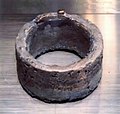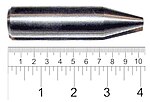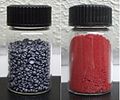alloys of neptunium with uranium, americium, plutonium, zirconium, and iron, so as to recycle long-lived waste isotopes such as neptunium-237 into shorter-lived...
113 KB (13,685 words) - 23:18, 13 September 2024
Plutonium (section Isotopes and nucleosynthesis)
neutron irradiation of neptunium-237. Plutonium isotopes undergo radioactive decay, which produces decay heat. Different isotopes produce different amounts...
139 KB (14,903 words) - 22:49, 12 September 2024
Enriched uranium (category Isotope separation)
increased through the process of isotope separation. Naturally occurring uranium is composed of three major isotopes: uranium-238 (238U with 99.2732–99...
48 KB (5,598 words) - 14:01, 26 August 2024
Depleted uranium (DU; also referred to in the past as Q-metal, depletalloy or D-38) is uranium with a lower content of the fissile isotope 235U than natural...
133 KB (14,639 words) - 03:48, 16 September 2024
the isotope nickel-63 located in a module the size of a very small coin. As it's consumed, the nickel-63 decays into stable, non-radioactive isotopes of...
25 KB (2,763 words) - 17:32, 9 July 2024
Praseodymium (section Isotopes)
isotopes lighter than 141Pr is positron emission or electron capture to isotopes of cerium, while that of heavier isotopes is beta decay to isotopes of...
37 KB (4,830 words) - 15:05, 16 September 2024
call these elements with complete chemical identity "isotopes". The problem of placing isotopes in the periodic table had arisen beginning in 1900 when...
91 KB (11,029 words) - 10:26, 25 August 2024
93 (neptunium) and 94 (plutonium), for the discovery of fission in other elements, and for the determination of the role of the uranium-235 isotope in...
99 KB (12,607 words) - 04:05, 20 August 2024
























